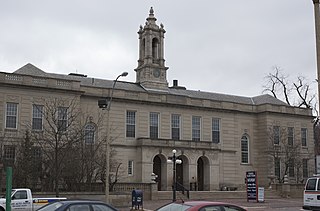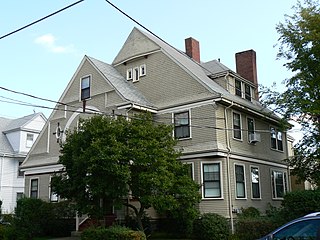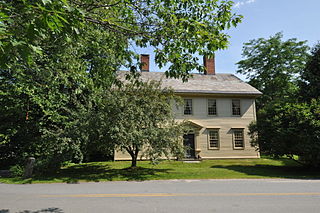
Arlington is a town in Middlesex County, Massachusetts, United States. The town is six miles (10 km) northwest of Boston, and its population was 46,308 at the 2020 census.

The Reginald A. Fessenden House is a historic house in the village of Chestnut Hill in Newton, Massachusetts. It was the residence from 1919 to his death in 1932 of the inventor Reginald A. Fessenden (1866–1932), called "the father of radio broadcasting," because he was the first to broadcast the human voice and music by radio. The house was designated a National Historic Landmark in 1976 in recognition of Fessenden's accomplishments.
The following properties are listed on the National Register of Historic Places in Arlington, Massachusetts.
This National Park Service list is complete through NPS recent listings posted August 16, 2024.
Robinson House may refer to:

The Glebe House, built in 1854–1857, is a historic house with an octagon-shaped wing in Arlington County, Virginia. The Northern Virginia Conservation Trust holds a conservation easement to help protect and preserve it. The name of the house comes from the property's history as a glebe, an area of land within an ecclesiastical parish used to support a parish priest. In this case, the glebe was established by the Church of England before the American Revolutionary War.

The Arlington Center Historic District includes the civic and commercial heart of Arlington, Massachusetts. It runs along the town's main commercial district, Massachusetts Avenue, from Jason Street to Franklin Street, and includes adjacent 19th- and early 20th-century residential areas roughly bounded by Jason Street, Pleasant Street, and Gray Street. The district was listed on the National Register of Historic Places in 1974.

The Ephraim Cutter House is a historic house at 4 Water Street in Arlington, Massachusetts. Built about 1804 by one of the town's leading mill owners, it is one of Arlington's few surviving Federal period houses. It was listed on the National Register of Historic Places in 1978, and included in an expansion of the Arlington Center Historic District in 1985.

The Fowle-Reed-Wyman House is a historic First Period house in Arlington, Massachusetts. The house is a two-story wood-frame saltbox structure with integral lean-to, central chimney, and clapboard siding. Built about 1706, it is the oldest structure in Arlington, and is the best-preserved of the three First Period houses left in the town. A c. 1915 addition, sympathetic in style, extends to the rear. The house was built by John Fowle, who had inherited the land from his mother, and was sold the following year to Daniel Reed. From 1775 to 1924 the house was owned by members of the Wyman family.

The Highland Hose House is a historic fire station at 1007 Massachusetts Avenue in Arlington, Massachusetts. The two story brick building was built in 1928 to a design by George Ernest Robinson. His Georgian Revival design emulates features found in Boston townhouses of the late 18th and early 19th centuries, and its cupola and grasshopper weathervane resemble that of Faneuil Hall. The station includes a bronze relief of former Chief Charles Goff, executed by noted Arlington resident Cyrus Dallin.

The William Prentiss House is a historic Greek Revival style house in Arlington, Massachusetts. Built c. 1860, it is one of the oldest houses in the Arlington Heights neighborhood of the town. It is 2 and a half stories in height, with a side gable roof that has a large shed-roof dormer. A 20th-century porch extends to the left side, and the centered entrance is sheltered by a modern glassy shallow vestibule. Stylistically, the house resembles a number of houses built in East Arlington around the same time, but is the only one of its type in this neighborhood. William Prentiss, a local farmer, was its first known owner. The house was listed on the National Register of Historic Places in 1985.

The Robinson House is an historic house in Arlington, Massachusetts. The 2+1⁄2-story wood-frame house was built in 1846 after the introduction of train service into Arlington. It has retained some of its Greek Revival styling despite the application of siding.

The Ella Mahalla Cutter Sterling House is a historic house in Arlington, Massachusetts. The 2+1⁄2-story wood-frame house was built c. 1845, and is considered one of Arlington's finest Greek Revival houses. It was built by Cyrus Cutter, father of Ella Mahalla Cutter Sterling, and member of a family that lived in what is now Arlington since the 17th century. It has a fully pedimented front-facing gable, with a flat-roof single-story porch supported by fluted Doric columns. Corner pilasters rise to an entablature that encircles the building.

The Henry Swan House is a historic house in Arlington, Massachusetts. The 2+1⁄2-story wood-frame house was built in 1888 by Henry Swan, a Boston poultry dealer who was also active in local politics. The house is a well-preserved example of the sort of late Victorian houses that were once much more typical along Massachusetts Avenue.

The Stephen Symmes Jr. House is a historic house in Arlington, Massachusetts. It is built on land that was held in the Symmes family since 1703, when it was purchased from a Native American. Although it has been claimed to date to 1746, the house was probably built in 1841, and may incorporate parts of an older building within it. The building is one of the finest examples of Greek Revival architecture in Arlington, with a pillared porch on two sides. The house is notable for its association with Stephen Symmes Jr., who bequeathed this property to the town for use as a hospital.

The Taylor-Dallin House is a historic house in Arlington, Massachusetts. The house is notable as being the home of sculptor Cyrus E. Dallin (1861–1944) from 1899 until his death. It is a Colonial Revival/Shingle style 2+1⁄2-story wood-frame structure, with a hip roof studded with dormers, and a front porch supported by Tuscan columns. The house was built c. 1898 by Jack Taylor and sold to Dallin in 1899. Dallin's studio, no longer extant, stood in the rear of the property. Dallin was one of Arlington's most well-known citizens of the early 20th century, and his sculptures are found in several public settings around the town.

The House at 5–7 Winter Street in Arlington, Massachusetts is a rare late-19th century two family house in East Arlington. The wood-frame house was built in 1895 by John Squires, who owned a garden farm. It was built as a speculative venture at a time before Arlington's market gardeners began selling their land off for development. The building exhibits well-preserved Queen Anne styling, with asymmetric massing characteristic of that style, and a judicious use of decorative cut wood shingles.

The Lewis House is a historic house at 276 Woburn Street in Reading, Massachusetts. The 2+1⁄2-story wood-frame house was built in the late 1870s by John Lewis, a successful shoe dealer. The house is three bays wide, with a hipped roof with a single gable dormer. The roof has extended eaves with false rafter ends that are actually lengthened modillion blocks; these features give the house a Colonial Revival feel. The corner boards are pilastered, and the front entry is flanked by half-length sidelight windows and topped by a pedimented lintel, above which is a round fanlight window.

The Whittemore House is a historic house in Arlington, Massachusetts. The Greek Revival was built c. 1850, and is the only house in Arlington with the full temple-front treatment. It as two-story fluted Doric columns supporting a projecting gable end with a fan louver in the tympanum area. The entrance is located in the rightmost of the front facade's three bays, and is framed by sidelight and transom windows. The building's corners are pilastered, and an entablature encircles the building below the roof.

The Oak Grove Cemetery is an historic cemetery on Jones Road in Falmouth, Massachusetts.

The Joseph Fessenden House is a historic house at 58 Bridge Street in Royalton, Vermont. Built about 1802, it is a high quality local example of transitional Georgian-Federal architecture. It was listed on the National Register of Historic Places in 2002.




















